Eventually, we’ll be able to sequence the human genome and replicate how nature did intelligence in a carbon-based system. (Bill Gates)
After over a decade of research and billions of dollars invested in the Human Genome Project, in April 2003, we actually managed to do so, proving Bill Gates right once again and opening a path to pharmacogenomics and the early and precise prediction, diagnosis, and treatment of serious diseases such as cancer, HIV, or rare genetic diseases. Software for genomic analysis has been slowly turning into a key component of the healthcare infrastructure, revolutionizing biological research and the way millions of scientists from all over the globe access crucial genomics data. Genomic software tools have become valuable assets not only for genomic specialists but also for specialists operating in fields such as biophysics, bioengineering, molecular biology, or ecology.
Global Genomic Market Trends
According to the National Human Genome Research Institute, by 2025, genomics research is expected to generate anywhere between 2 and 40 exabytes of data. To help neophytes grasp the magnitude of this prediction, NIH resorted to eloquent parallelism with the famous movie Jaws.
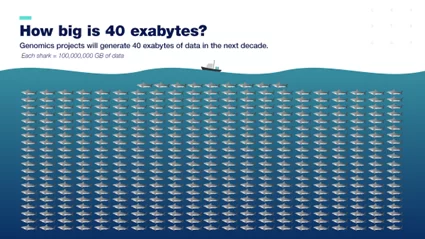
Source: https://www.genome.gov/about-genomics/fact-sheets/Genomic-Data-Science
Considering that one single human genome sequence would take up the space of approx. 200 copies of Jaws, there is no wonder that genomics is currently considered a Big Data science, expected to soon be on par – in terms of data acquisition, storage, distribution, and analysis – with some of the biggest data generators: YouTube, Twitter, and astronomy.
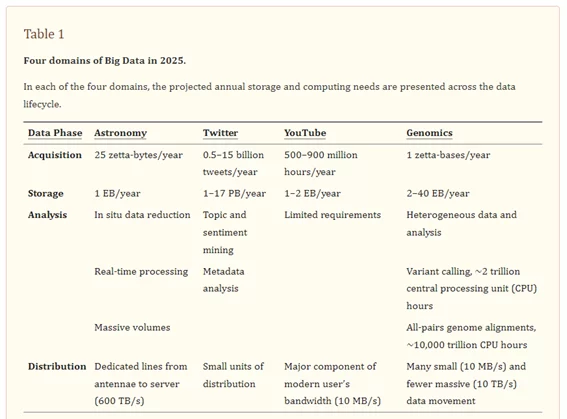
Source: https://www.ncbi.nlm.nih.gov/pmc/articles/PMC4494865/table/pbio.1002195.t001/
But how does all this data add up to real money? According to Research and Markets, in 2020, the global genomics market was valued at an impressive US$ 25.1 Billion. According to estimations, by 2027, it will expand at an annual growth rate (CAGR) of 15.73%, expected to reach US$ 60.3 Billion.
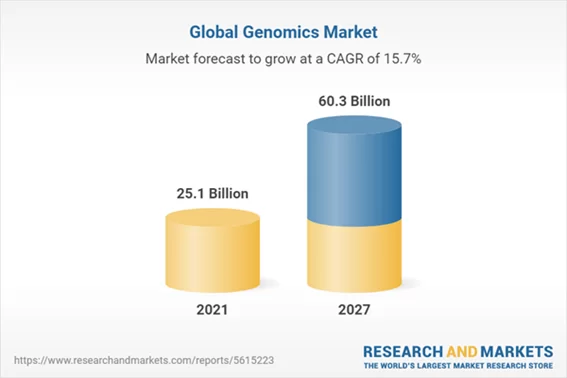
Under the promise that genomic medicine will revolutionize the prevention, diagnosis, and treatment of diseases – compounded with the outbreak of the COVID-19 pandemic, the growing demand for customized drugs, increased government funding, reduced sequencing costs (currently under $1,000) thanks to impressive technological advancements, an increased number of emerging companies and start-ups – the global genomics market has experimented an unprecedented growth.
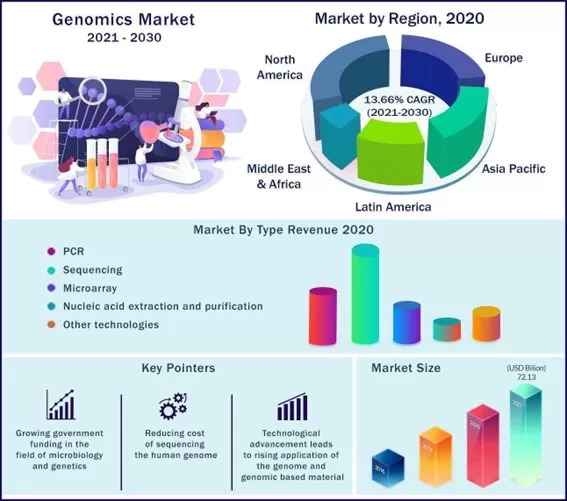
Source: https://www.precedenceresearch.com/genomics-market
Genomics software types
The genomics market is segmented into two main categories: services and products. Alongside consumables, software belongs to the products segment, which, by 2028, is expected to keep dominating the market. According to Fortune Business Insights, in 2020, the product segment was already dominating the market and will continue to do so in the upcoming decade.
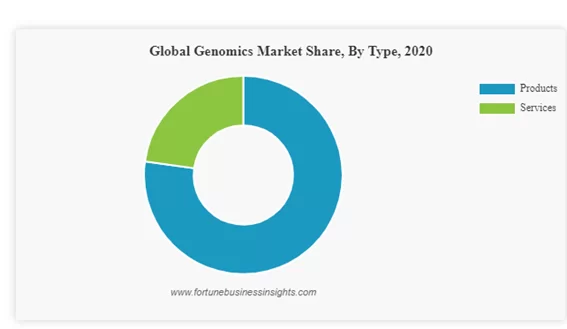
As we have already seen, the impressive amount of genetic data has given birth to a pressing need for software and other automated products to facilitate data analysis. From software for genomic data analysis to gene expression microarray, genomics relies on advanced solutions for streamlined analysis and interpretation of genetic data on a global scale. Let’s take a look at some relevant examples.
TruSight Software Suite (Illumina Inc.)
One of the key players in the genomics market, Illumina Inc. aims at improving healthcare by unlocking the genetic trove. Launched in 2020, Illumina’s TruSight Software Suite is a ready-to-use infrastructure designed to be comprehensively used as a reporting, case management, visualization, evidence retrieval, and variant filtering tool for rare genetic diseases. According to Ryan Taft, Vice President of Scientific Research at Illumina, “This combination of products will set the standard for scalable and swift interpretation of genomic information, enabling whole-genome sequencing to become the standard of care in rare diseases. By enabling users to quickly sift through millions of variants to find an answer, we will make it easier for rare disease patients to benefit from valuable genomic insights.”
Key features:
- Whole-genome sequencing
- Enables sample-to-report analysis
- Reduces the test interpretation time to a few hours
- Compatible with NovaSeq 6000, DRAGEN Bio-IT, and DNA PCR-Free Prep
CentoCloud (Centogene)
Aimed at facilitating state-of-the-art genomic testing and generating comprehensive medical reports, this fully-automated bioinformatics pipeline is supported by CENTOGENE’s Biodatabank, one of the largest data repositories in the world for neurodegenerative and rare diseases. Using standard and AI-powered clinical data extraction, CENTOGENE’s Biodatabank combines clinical information, multi-omic data, sociodemographic data, and biomaterial.
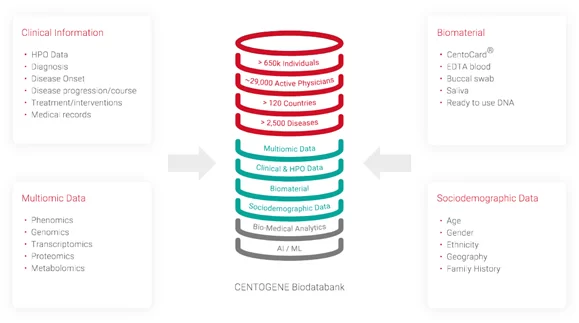
Main features:
- Automated cloud-based SaaS platform for fast bioinformatics analysis and interpretation of NGS data
- AI-powered variant prioritization, classification, and re-classification
- Phenotype-genotype unified database
- Variant annotation and filtering tool
- End-to-end workflow
- Allows for state-of-the-art customized patient care
- CE-marked IVD software for genomic diagnostics
Integrative Genomics Viewer (IGV)
Funded by the National Cancer Institute (NCI) of the National Institutes of Health, the Informatics Technology for Cancer Research (NCI), and the Starr Cancer Consortium, this high-performance tool solved one pressing problem: genomic data and annotations visualization. Fast, efficient, and reliable, this visualization tool allows scientists to interactively explore vast, integrated genomic datasets.
Main features:
- Offers support for a wide range of data types such as genomic annotations, array-based data, or NGS data
- Integration of clinical and phenotypic data
- Supports both local and remote data sets
- Allows for simultaneous data visualization in multiple genomic regions
- Compatible with Windows, Mac, and Linux
- Available as a desktop app, web app (IGV-Web), JavaScript component for developers (igv.js)
- Free to download under a GNU LGPL open-source license
Are we actually witnessing the incipient phases of the genomics revolution?
The COVID-19 pandemic showed us how genomics can be used to monitor and detect emerging variants. Somehow, it was not a novelty since healthcare and medical research have always been the main use areas. However, a report – entitled Genomics Beyond Health – published in January 2022 in the UK by the Government Office for Science puts genomics into a whole new light. As scientists acquire more and more data about the human genome and the way it works, there is a growing interest in how genomes influence non-health traits such as substance abuse, risk-taking, educational performance, etc. To what extent could genomics impact our lives in the near future? Polygenic prediction at birth could be used to improve educational outcomes by making possible earlier interventions (e.g. specific learning approaches). Genomic predictions may allow law forces to deter those people who are predisposed to criminal behavior. Could genomic analysis determine if a person is suitable or not for a certain job? Since most personality traits are heritable, the answer is YES. Genomic sequencing could revolutionize forensic science by predicting the physical features and age of the murdered from a DNA sample. These are only some examples. It wouldn’t be too risky to say that, as new technologies emerge, the possibilities in both health-related and non-health-related areas are virtually endless.
Wrap Up
Fuelled by various determining factors such as the growing demand for precision medicine and customized treatments, public and private funding for research projects, notable technological advancements, or lower sequencing costs, the genomics software market will continue to grow rapidly over the next decade. Undoubtedly, the ability to sequence a whole genome and analyze genomic data fast and cost-effectively paves the path for exciting new ways to predict, prevent, diagnose, and treat diseases.









